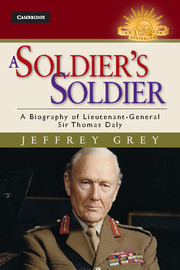Book contents
- Frontmatter
- Contents
- Illustrations
- Maps
- Tables and diagrams
- Acknowledgements
- Abbreviations
- Chapter 1 Regimental soldiering
- Chapter 2 Balikpapan, 1945
- Chapter 3 ‘He could fill any appointment with distinction’
- Chapter 4 The challenges of senior rank
- Chapter 5 Chief of the General Staff
- Chapter 6 Daly, the army and the war in Vietnam, 1966–71
- Chapter 7 The civic action crisis, 1971
- Chapter 8 Epilogue
- Notes
- Sources and Bibliography
- Index
Chapter 1 - Regimental soldiering
Published online by Cambridge University Press: 05 February 2014
- Frontmatter
- Contents
- Illustrations
- Maps
- Tables and diagrams
- Acknowledgements
- Abbreviations
- Chapter 1 Regimental soldiering
- Chapter 2 Balikpapan, 1945
- Chapter 3 ‘He could fill any appointment with distinction’
- Chapter 4 The challenges of senior rank
- Chapter 5 Chief of the General Staff
- Chapter 6 Daly, the army and the war in Vietnam, 1966–71
- Chapter 7 The civic action crisis, 1971
- Chapter 8 Epilogue
- Notes
- Sources and Bibliography
- Index
Summary
Armies are living entities, human organisations that develop their own cultures and characteristics over time. Some armies have commonalities, but no two national armies are the same, although they might, on occasions, be alike. Field Marshal Lord Carver, a senior soldier and noted scholar of his institution, wrote of the British Army as possessing seven ‘ages’, periods associated with an individual such as Marlborough, Wellington or Montgomery, who dominated or typified a period in the life of the institution. The Australian Army was, and is, a ‘British-pattern’ army; it has many things in common with its British counterpart, but is not the same institution. It lacks, for example, a tradition of ‘great captains’, which provided Carver with a useful organising device around which to structure his account of the British Army's history. The Australian Army's development nonetheless can be organised around a ‘generational’ perspective, one that helps to identify both the continuities and distinct differences in different periods of its existence.
The army emerged from the tangle of confusions that accompanied Federation, the establishment of the Commonwealth of Australia and the gradual development of centralised government at the federal level. The first generation of the army came of age during the Great War and reached its culminating point in 1918, both on the Western Front and in Palestine (the latter often being overlooked). Thereafter it entered a period of neglect and decline that saw the Regular Army, at least, attenuated almost out of existence by the early 1930s. The growing threat of war in Europe and Asia led to the renewal of the army and arguably to its greatest achievements during the latter half of the Second World War, during which its senior leadership functioned at the strategic level for the first time. As with the generation following the Great War, this army was quickly broken up and the organisation ‘forgot’ much of what it had learned at such expense during the Pacific War. However, unlike the 1920s, the army's leadership was able to take the organisation forward into a new generation of development and activity, made possible both by the very different strategic circumstances that confronted the nation after 1945 and, ironically perhaps, by a shared memory of the consequences of decisions made by an earlier generation of political leadership.
- Type
- Chapter
- Information
- A Soldier's SoldierA Biography of Lieutenant General Sir Thomas Daly, pp. 1 - 36Publisher: Cambridge University PressPrint publication year: 2012



